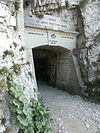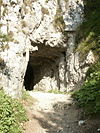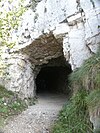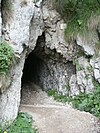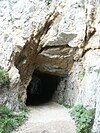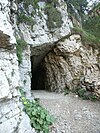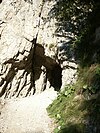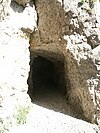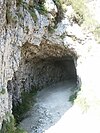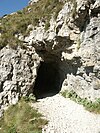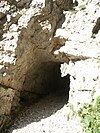|
Strada delle 52 Gallerie
The Strada delle 52 Gallerie ("Road of 52 tunnels"), also known as the 52 Tunnel Road, or Strada della Prima Armata ("Road of the First Army") is a military mule road built during World War I on the Pasubio massif in Veneto, Italy. The road winds between Bocchetta Campiglia (1,216 metres [3,990 ft]) [1] and the Porte del Pasubio (1,934 metres [6,345 ft]) [2] crossing the southern slope of the mountain with its spires, deep canyons and sheer rock faces, outside of the range of Austro-Hungarian artillery. FeaturesIt is 6,555 metres (21,506 ft) long, of which 2,335 metres (7,661 ft)[3] are divided into 52 tunnels excavated from the rock, each tunnel is numbered and characterized by a particular name. The minimum width of 2.20 metres (7.2 ft) was originally intended to allow the transit of two mules with their baggage. [4] The slope of the road reaches 22 percent, with an average of 12 percent.[4] Notable among the many tunnels is the 19th because, in addition to being the longest (320 metres (1,050 ft)), it has a helical layout with 4 hairpin bends, inside a gigantic rock tower.[5] The Tunnel 20 is carved out of a rock tower, and to overcome the difference in height, twists around itself like a corkscrew. Tunnels 41 through 45 run below the Passo Fontana d'oro (1,875 metres [6,152 ft]). On leaving the 47th, the highest point of the road (2,000 metres [6,562 ft]), there is a magnificent panorama.[peacock prose]   CompletionA masterpiece of military engineering and boldness (it was produced by the 33rd Miners Company of the Italian Army with the help of six hundred workers), considering the conditions and the time it was built, and the speed of execution. Work began on February 6, 1917, and was completed in November 1917. Its implementation was of great strategic importance because it allowed communication and transfer of supplies from the base to the summit area of Mt. Pasubio. Key aspects of the road include year round access, located outside of enemy artillery range and accessible by mule. These were all problems with the similar road of Scarubbi which is only accessible with motorized vehicles, within the range of the Austro-Hungarian guns, and only during the summer. Mountain biking is strictly prohibited due to a number of fatal accidents.
Similar Treks
ReferencesNotes
Cartography
Bibliography
External links
|
||||||||||||||||||||||||||||||||||||||||||||||||||||||||||||||||||||||||||||||||||||||||||||||||||||||||||||||||||||||||||||||||||||||||||||||||||||||||||||||||||||||||||||||||||||||||||||||||||||||||||||||||||||||||||||||||||||||||||||||||||||||||||||||||||||||||||||


